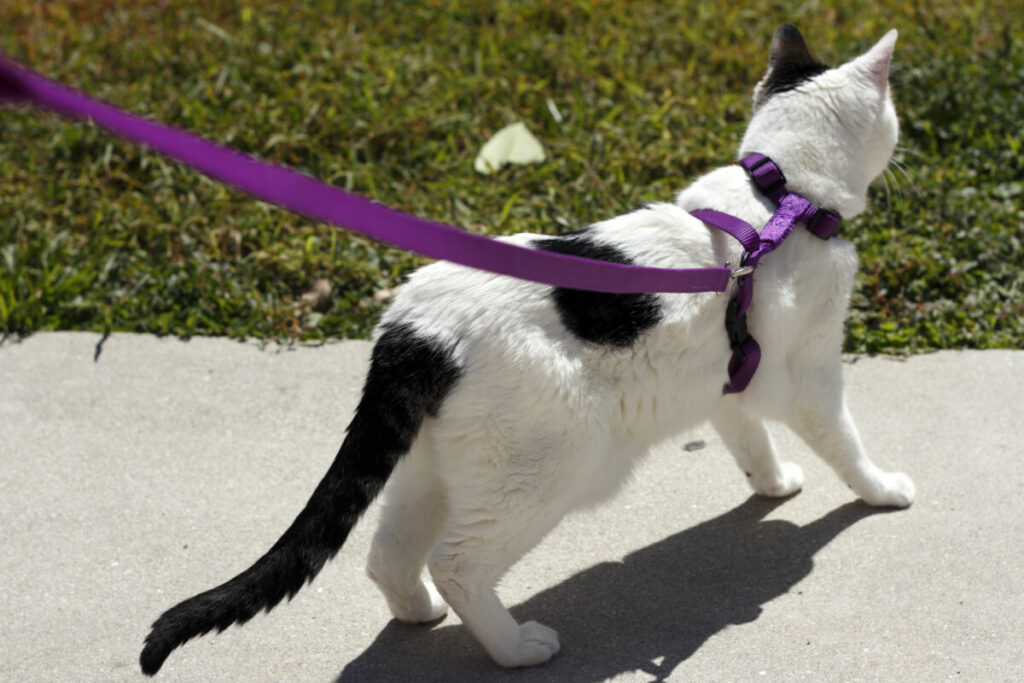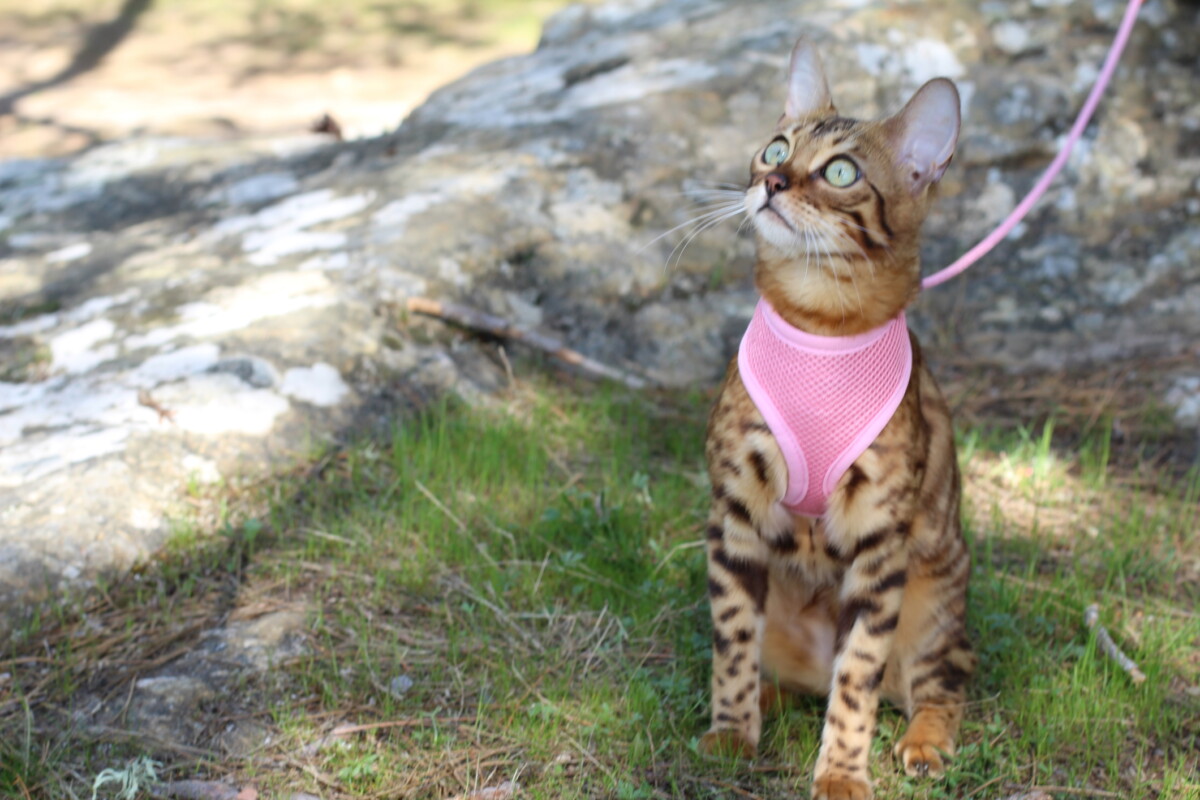If you’re wanting to walk a cat on a leash, you’ll need to use a harness to avoid having your furry friend squirm out of their collar and make a run for it. Cats are finicky, however, and enjoy having the freedom to roam as they please. Because of this, you may be asking yourself if it is cruel to put your cat into a harness at all.
As a general rule, it is not cruel to harness a cat if they have been properly trained. Correct usage of the harness is also important for ensuring the safety of the cat.
In this article, I will explore both the benefits of walking a cat on a harness and how to do so safely.
Does a Harness Hurt a Cat?
When put into a harness, cats can become fussy and may pull at the restraints in an attempt to get out. This isn’t because the cat is in pain, but because they are uncomfortable in the unfamiliar harness.
A harness won’t hurt your cat as long it’s an appropriate size and isn’t fastened too tightly. Additionally, you never want to pull your cat or force them to walk somewhere in the harness. A harness is better suited for walking a cat than a breakaway collar alone, and when worn correctly, it won’t hurt your cat.
After putting a harness on your cat, you may notice a strange response in which they tense up, flop over, and then refuse to move. Many owners assume their cat has somehow become paralyzed by the harness.
In actuality, this is simply a behavioral response triggered by the presence of the harness and is nothing to be concerned about. Of the most common pets, cats have been domesticated for the least amount of time and still have many instincts present that may not make much sense when observed outside of the wild.
Many cats instinctively perceive a harness as a predator who has caught them. This triggers their freeze response in hopes that the predator will become distracted by another still-moving prey, which will allow them to escape.
Luckily, this response and other anxieties related to the harness can be overcome with proper training that I will be covering in this article.
Do Cats Like Being Walked on a Harness?
Many people wonder if cats like being walked on a harness when they have so much anxiety associated with wearing one for the first time.
Despite some initial adverse reactions, with time and patience, indoor cats can come to enjoy walks outside of their home. Exploring new areas can be mentally refreshing for your cat and provide them with necessary physical activity.
However, it is important to remember that cats vary in personality and some may be much happier staying inside than going out to explore. Cats also have different needs when it comes to the amount of stimulation and exercise they require to remain happy and healthy.
Both the personality and individual needs of your cat may affect how often and how far they want to walk on a harness.
Leash Training a Cat
To begin training your cat to walk on a leash you must first get it used to wearing a harness. Start this process by putting the cat into the harness for short periods of time while at home. Keep the first few wearing sessions under five minutes and only once a day.
While the cat is harnessed it’s very important to give them lots of love and a few treats so that they begin to associate positive experiences with the harness. Over time as the cat gets more comfortable begin to increase the time to 10 minutes, and then 15 minutes.
According to the Homeward Pet Adoption Center, once your cat can comfortably wear a harness for 10-15 minutes they are ready to begin working on leash training. This should take place in a safe and quiet place that the cat is familiar with.
The first step of leash training is to attach a leash to your cat’s harness and then wait for the cat to acclimate while holding the leash, giving treats whenever the cat stops pulling on the lead. Then, once the cat is simply moving around and not pulling, begin walking with the cat to prevent tension on the leash.
Before you ever take your cat outside it is very important that you make sure their vaccines are up-to-date. Also, it is a good idea to ask your vet about flea/tick prevention and heartworm medication.

Once the cat has gotten comfortable with walking on a leash in the safe area, they are ready to begin exploring the outside world.
Just remember that unlike walking a dog on a leash, cats tend to prefer staying close to home—especially on the first few ventures. Also, you will need to give your cat more freedom to explore and lead than a dog. Cats like short bursts of exploration before returning home, so make sure to only keep walks between 10-15 minutes.
Walking a Cat Without a Leash
Some people may think the idea of walking a cat on a leash is weird and may consider walking their cat without a leash instead.
On average, people don’t actually find walking cats on leashes to be strange. Still, it’s important to be aware of the risks present when walking your cat without a leash.
The Royal Society for the Prevention fo Cruelty to Animals states that when cats encounter unfamiliar smells, sounds, and animals their instincts compel them to flee or climb the nearest object (or person) to escape the perceived threat.
Without a leash, your cat is likely to run and hide somewhere dangerous or inaccessible to humans. Because of this, walking a cat without a leash is greatly discouraged.
Final Thoughts: Walking Your Indoor Cat Outside
Walking a cat with a harness takes plenty of time and practice. Once the cat becomes used to the harness and leash, however, short walks can be quite enjoyable for them.
Begin introducing your cat to their harness slowly in short bursts over a few weeks in a safe environment. Once they are comfortable with the harness for extended periods of time, repeat the process with the leash attached to the harness.
Just remember that once your cat is ready to go outside their walks should be kept short (10-15 minutes) and near home where your cat is most comfortable. This allows them to feel safe knowing that they can retreat back into the house if they encounter any threats.
More Travel Tabby Content You May Enjoy:
- Is It Weird To Walk a Cat on a Leash? Facts vs. Opinions
- 6 Best Food and Water Bowls for Traveling with Cats
- How Long Can a Cat Be in a Cat Backpack?

